IHMC’s Nadia Is a Versatile Humanoid Teammate

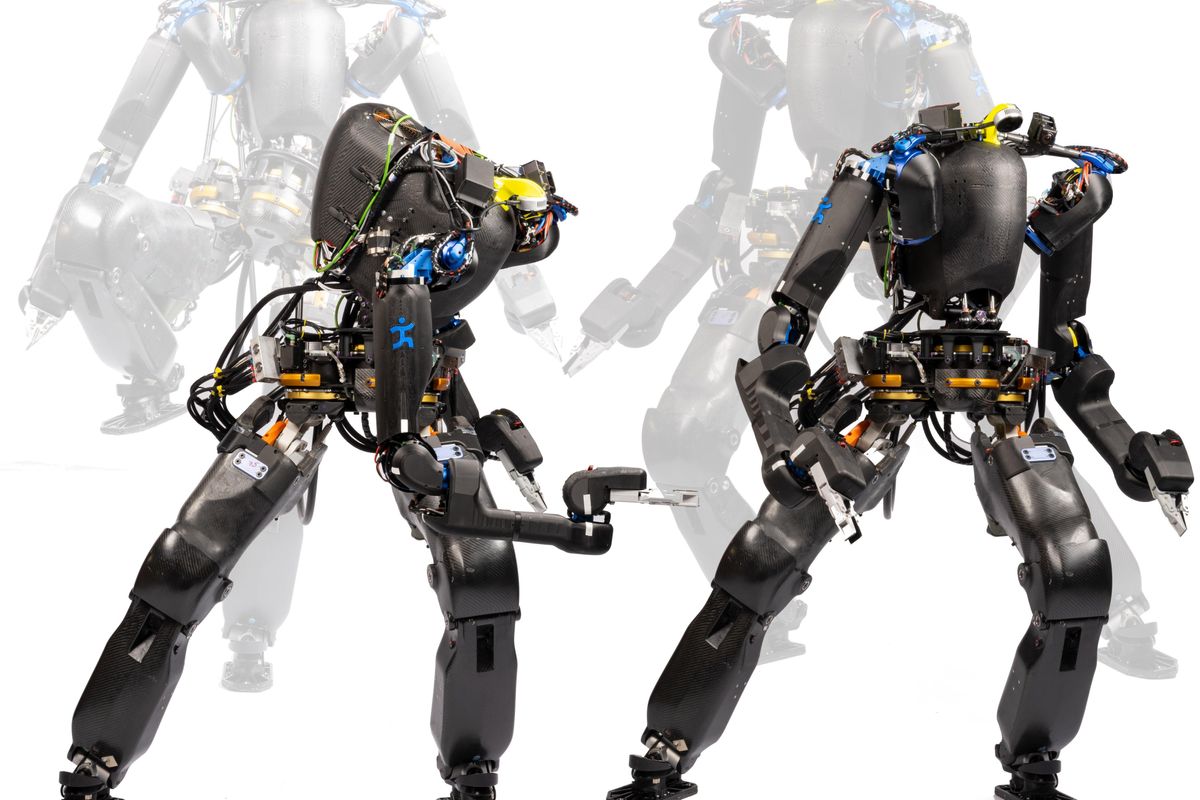
The Florida Institute for Human & Device Cognition (IHMC) is effectively recognised in bipedal robotics circles for instructing pretty intricate humanoid robots to wander. Since 2015, IHMC has been dwelling to a Boston Dynamics Atlas (the DRC model) as nicely as a NASA Valkyrie, and major development has been designed on advancing these platforms toward dependable mobility and manipulation. But essentially, we’re speaking about some incredibly outdated components below. And there just aren’t a whole lot of fantastic alternative options (accessible to researchers, anyway) when it comes to humanoids with human-equivalent toughness, velocity, and versatility.
Various years ago, IHMC resolved that it was substantial time to establish its have robot from scratch, and in 2019, we observed some pretty awesome plastic ideas of Nadia—a humanoid intended from the ground up to conduct practical responsibilities at human velocity in human environments. Just after 16 (!) experimental plastic variations, Nadia is now a authentic robotic, and it by now looks pretty amazing.
For a lengthy time, we’ve been pushing up from the limits of the components with DRC Atlas and Valkyrie. We have not been capable to totally take a look at the restrictions of our software and our controls. With Nadia, it’s the other way all around, which is really exciting from a investigate viewpoint.
—Robert Griffin, IHMC
Designed to be basically the upcoming era of the DRC Atlas and Valkyrie, Nadia is a lot quicker, extra flexible, and robust sufficient to make an great exploration platform. It’s a hybrid of electric and hydraulic actuators: 7 degrees-of-flexibility (DoF) electric powered arms and a 3 DoF electric powered pelvis, coupled with a 2 DoF hydraulic torso and 5 DoF hydraulic legs. The hydraulics are built-in sensible actuators, which we’ve protected in the earlier. Nadia’s joints have been organized to increase variety of motion, that means that it has a dense manipulation workspace in entrance of by itself (exactly where it actually matters) as well as really cell legs. Carbon fiber shells covering most of the robot enable for safe make contact with with the surroundings.
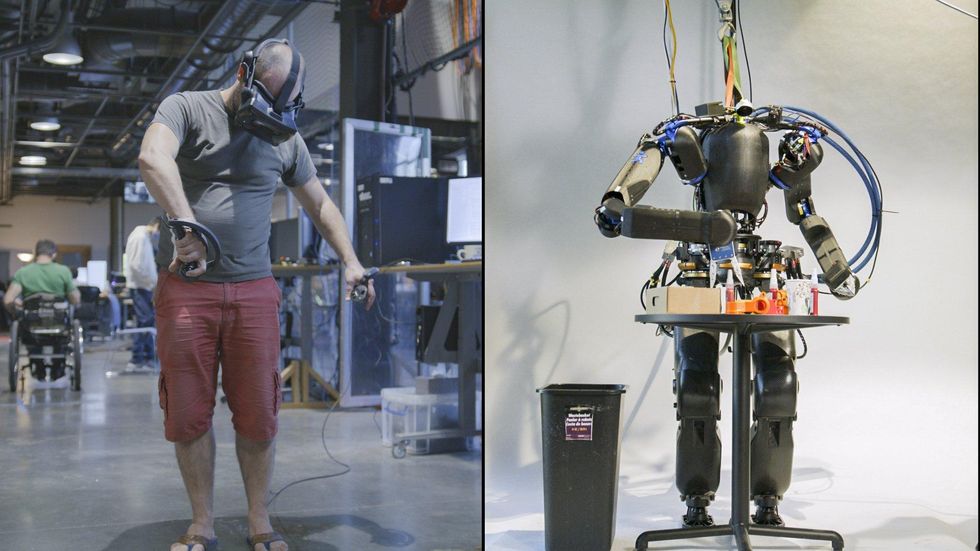
Teleoperation by means of immersive digital truth aids Nadia accomplish intricate responsibilities.IHMC
That significant manipulation workspace is particularly applicable for the reason that there is a whole lot of emphasis on immersive virtual truth teleoperation with Nadia. Not that autonomy is not crucial, but the notion driving Nadia has been shaped (at the very least in part) by IHMC’s practical experience at the DARPA Robotics Problem Finals: Preferably, you want the robotic to handle everything it can on its possess, while owning a human ready to choose far more immediate manage in excess of advanced jobs. Even though it’s not the fantasy of a robotic becoming fully autonomous, the simple fact is that in the in the vicinity of expression, this tactic is an straight away feasible way of acquiring robots to reliably do helpful matters in unstructured environments. Over-all, the purpose with Nadia is to function as close to human speed as achievable when carrying out urban exploration and manipulation tasks. And if that requires a human right teleoperating the robotic because which is the ideal way of accomplishing points, Nadia is created to cope with it.
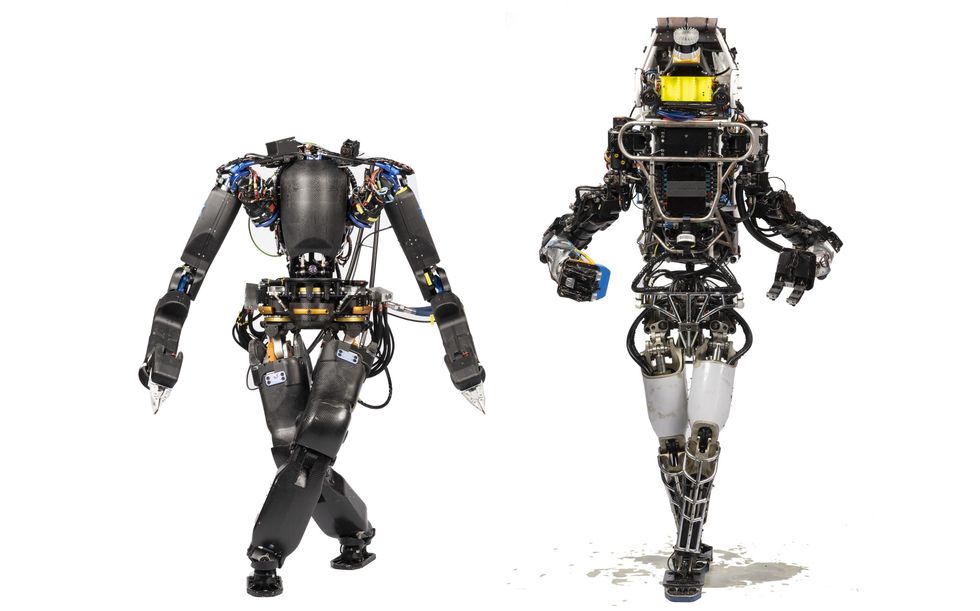
Nadia demonstrates how significantly much more adaptable its hips and legs are relative to DRC Atlas.IHMC
For more details about Nadia, we spoke with Robert Griffin, a analysis scientist at IHMC.
How is Nadia distinctive among humanoid robots?
Robert Griffin: I consider the large point that we’re making an attempt to deliver to the table with Nadia is the truly large assortment of motion of a ton of the joints. And it is not just the variety of motion that differentiates Nadia from a lot of other humanoid robots out there, it is also velocity and ability. Nadia has significantly far better ability-to-weight than the DRC Atlas, building it drastically a lot quicker, which increases its normal operational velocity as very well as its balance.
Can you set your plans with Nadia into context in the humanoid robotics house?
Griffin: We’re seeking to make Nadia a robot that can function in unstructured environments exactly where you don’t know what it desires to do in advance of time. So, as an alternative of obtaining a established sequence or variety of tasks, we’re trying to make up a robotic in components, computer software, and interfaces that empower a human-device group to go into an unknown atmosphere, check out it, map it, and then do significant tasks.
IHMC has a status for assisting sophisticated humanoid robots like DRC Atlas and Valkyrie with their mobility. How has all of that expertise produced its way into Nadia’s style?
Griffin: You are right, and we’ve been partnering with NASA JSC due to the fact the DRC—when you see Valkyrie going for walks now, it’s utilizing IHMC program and controllers. When it will come to making use of some of that expertise to Nadia, we’ve paid unique interest to matters like Nadia’s vary of movement in its legs. Contrary to a ton of humanoid platforms, Nadia has really superior hip roll (or ab/adduction), which suggests that it can do truly large measures and also actually narrow techniques where by the toes overlap each other. We believe which is likely to support maximize mobility by aiding with phase adjustment and achieving tough footholds.
Further than the components, we were being also able to use our simulation resources and control stack to genuinely assistance us specify what the components design required to be in buy to complete some of these jobs. We weren’t in a position to optimize all of the joints on the robot—we very significantly stuck with a one hydraulic piston in the legs, for now, but we hope that our long run layouts will be improved built-in and optimized. We do have total ankle actuation, in contrast to a great deal of humanoid robots. Our method, from the starting, was to look for the vital handle authority with Nadia’s toes to be able to do precise foot placement, and use that for rather fast reactive mobility.
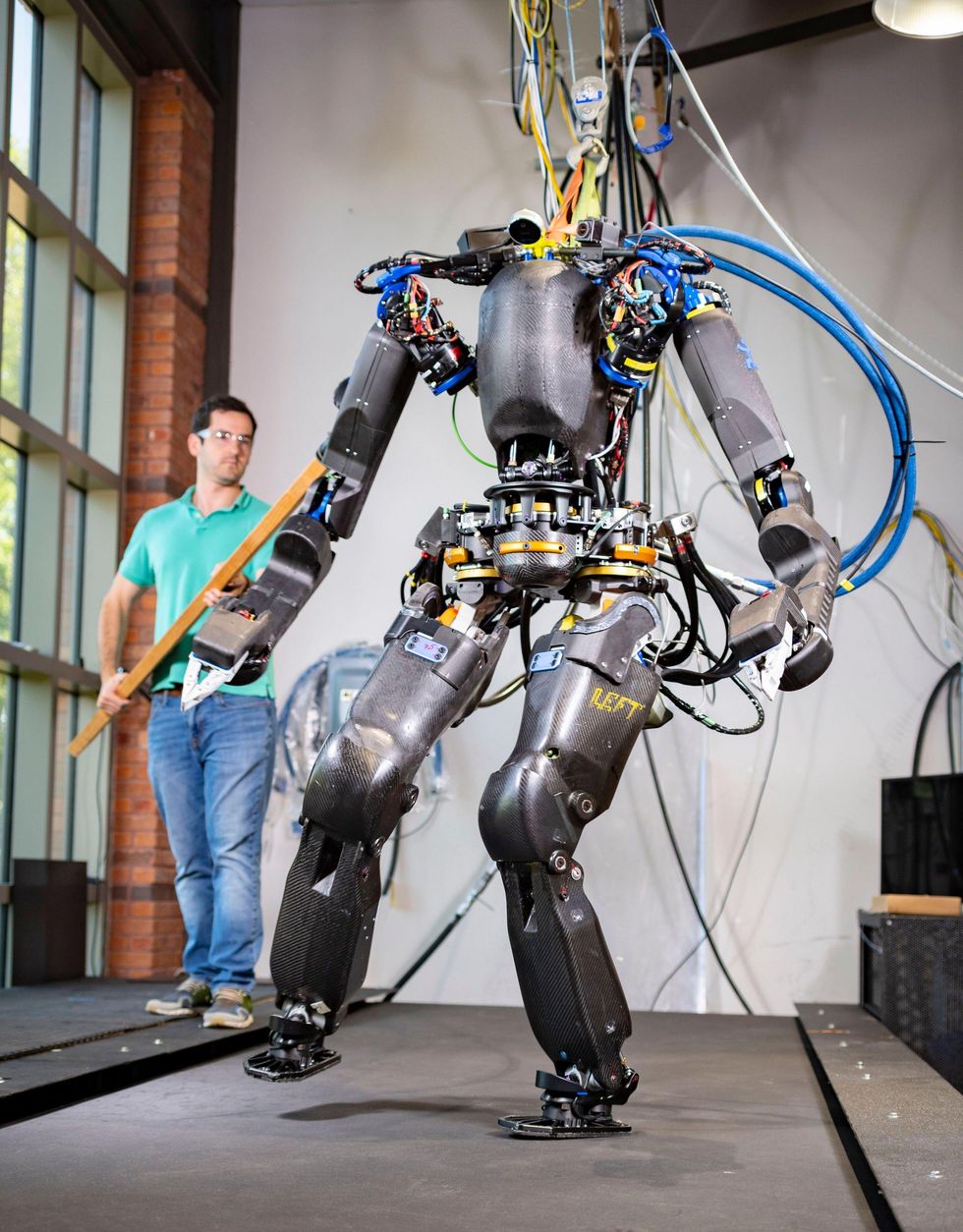
Robert Griffin gives Nadia a beneficial shove, for science.IHMC
As you went from notion to hardware with Nadia, what compromises did you have to make?
Griffin: We’re not very as adaptable as a typical human, although we’re not extremely far off. I was surprised that we dropped some selection of movement in the mechanisms just because of the hydraulic hose routing, specially about the hips, where we required to steer clear of having significant loops of hoses hanging off the robotic. We ultimately want to take Nadia into the genuine planet, and we don’t want the hoses finding snagged on issues.
Nadia is not very as fast as a human in some of the joints, and in some of the joints it is faster. We’re also not quite as compact as we preferred to be initially, simply because, very well, robots are definitely really hard. We’re hoping to get it a little much more compact in the upcoming. And we skipped our bodyweight margin by a minimal bit—it’s about 90 kilograms ideal now, with no the hydraulic pump or battery on board.
Why did you decide to concentration on how a human can immediately management Nadia in VR, as opposed to a lot more emphasis on autonomy?
Griffin: Autonomy performs definitely, seriously nicely when you know what the running ailments are, and what you are striving to attain. Not that it’s effortless to automate that, but it is possible. We’ve experimented with some autonomous planning and manipulation, and we uncovered that it is a very little restricting in that it doesn’t acquire advantage of the total abilities of our system. And so what we’re on the lookout at doing is seeking to automate just vital components of the system—things like footstep preparing and grasp organizing, which can be automatic fairly perfectly. But we also require the ability to interact with novel environments, which is why we’re focusing on acquiring techniques to staff with humans by way of interfaces like virtual truth. With the cognitive abilities of a human put together with the manipulation capabilities of the robotic, we feel you get a ton of versatility.
How substantially of a variation has it designed to controlling Nadia in VR, that the hardware has humanlike adaptability and a humanlike workspace?
Griffin: For manipulation, it’s been large. We do not want the user to be operating the robotic and feeling like they are confined in what they can do because of the robot’s constraints. A lot of the manipulation that we have been able to do with Nadia we could under no circumstances have accomplished with our other platforms.
There are certainly trade-offs—the arms are a lot more built for velocity than for energy, which is going to be a minor bit limiting, but we’re hoping to enhance that long-phrase. I feel that designing the robot—and especially the command method and software program architecture—with the strategy of possessing a human running it has opened up a great deal of functionality that we hope will permit us swiftly iterate alongside a lot of different paths.
What are some issues that Nadia will be uniquely capable of?
Griffin: We’re hoping that the robotic will be uniquely able of multicontact locomotion—that’s a path that we’re genuinely hoping to move in, wherever we’re not just relying on our feet to move via the globe. But I don’t always want to say that it’ll be superior at that than other robots are, mainly because I really don’t know every thing that other robots can do.
Are there realistic responsibilities that you hope Nadia will be capable to do at some level in the long run?
Griffin: Points like catastrophe response, nuclear remediation, bomb disposal—these responsibilities are mostly done by persons appropriate now, mainly because we don’t have robots that are in fact capable of executing them sufficiently inspite of the total of time that roboticists have been operating on it. I consider that by partnering excellent robotic engineering with actually remarkable functioning interfaces and human cognition, these responsibilities will commence to grow to be possible to do by a robotic.
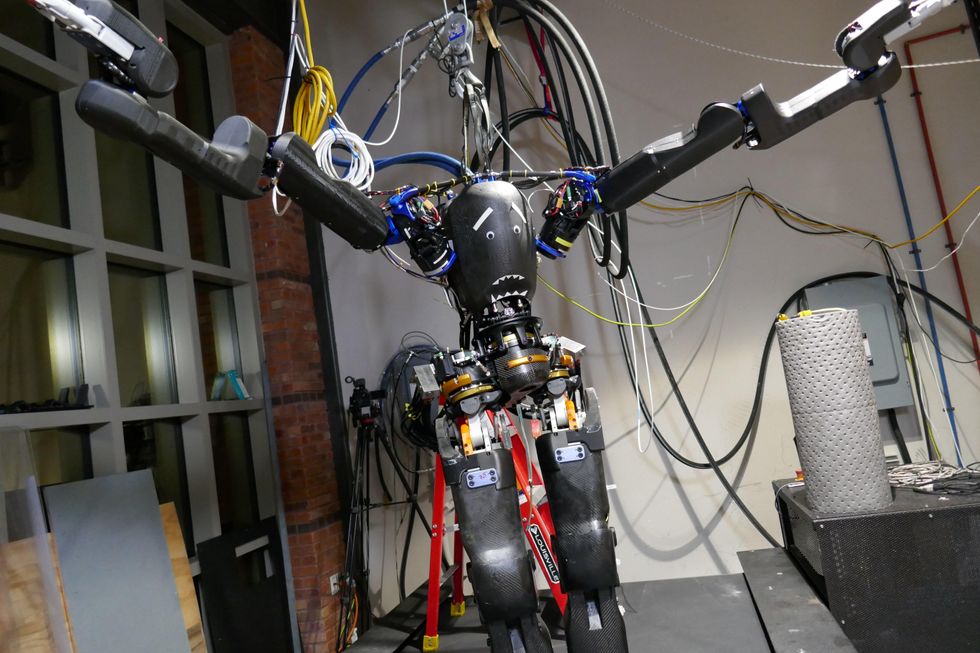
Who demands a true head when you have googly eyes and a shark mouth?IHMC
Even nevertheless Nadia is model new, IHMC now has a bunch of upgrades planned for the robotic. The most apparent a single is slicing that tether by putting batteries and a tailor made hydraulic pump into Nadia’s torso. Also on the road map are larger torque arms and lighter, a lot more streamlined legs. In the meantime, the software package has a large amount of catching up to do to let Nadia to reach its whole likely. And if we know IHMC, which is likely to be an incredibly enjoyable matter to see.




